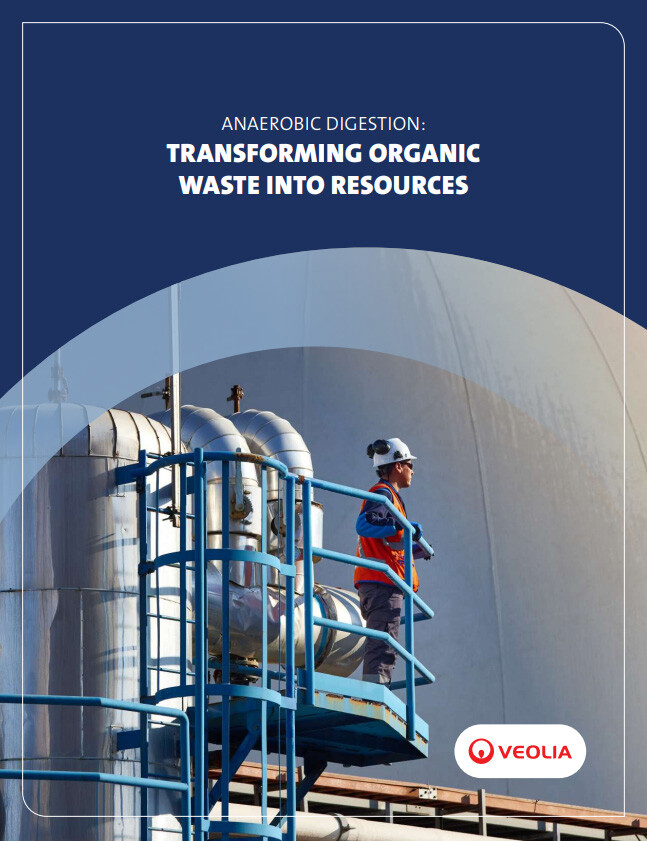The increase in the development of anaerobic digestion facilities is recognized as a solution to addressing the climate-related crisis around excess food waste. In Canada, since 2020, the number of anaerobic digestion (AD) facilities has more than doubled (Canadian Biogas & Biogas Market Report 2023, Canadian Biogas Association). Most of this development has been in Ontario, where anaerobic digestion (AD) facilities are diverting food waste from landfills and lowering greenhouse gas (GHG) emissions.
With an increasing demand for sustainability and resource efficiency, municipalities are investing in comprehensive processing programs to extract maximum value from organic waste to generate renewable energy from biogas, produce marketable agricultural products and offset operational costs, all under the framework of a burgeoning circular economy. In addition to stand-alone AD facilities, organic food waste can also be processed at wastewater treatment facilities, leveraging existing municipal infrastructure to co-locate organics processing. As many wastewater treatment facilities already have anaerobic digesters, there is the potential to add the processing of organics at underutilized facilities. This option is particularly attractive to communities seeking to leverage existing municipal infrastructure, and offer neighbouring communities an alternate destination to which they can send their organic wastes for processing.
The following highlights some of the key technical and operational aspects of co-locating of biowaste operations and the generation and conversion of biogas into a local, renewable energy, as well as the benefits, both environmental and financial, which can be derived for municipal governments.

Anaerobic Digestion
Anaerobic digestion, the process by which bacteria breaks down organic matter such as food waste, wastewater biosolids and animal manures, is being increasingly recognized as a solution to the climate-related crisis around excess food waste. In a growing number of locations around the world, AD facilities are diverting food waste from landfills and lowering GHG emissions, creating green energy and valuable soil amendments.
In Ontario, residents generate about 3.7 million tons of food and organic waste every year, with 60% of total food waste going into landfills (Reports on Organic Waste Management in Ontario, prepared for the Ontario Ministry of the Environment and Climate Change, 2015). With food waste in landfills being one of the largest contributors to methane emissions in Ontario, companies and government officials alike have continued to search for methods of food waste diversion to cut greenhouse gases. In Ontario, as well as in other jurisdictions in North America, governments are implementing regulations to ban residential and commercial food wastes and organics from landfills. This trend is necessitating an alternative sustainable approach to managing this ‘waste’ stream.
AD technology provides municipalities the ability to process large volumes of organic wastes in relatively close proximity to the source of its origin. Through the decomposition process, food and organic waste produces biogas, mainly composed of methane, a greenhouse gas that traps heat at 85 times the rate of carbon dioxide. Diverting that material from landfill to an AD facility, biogas can be converted into biomethane (also called renewable natural gas or RNG), creating a green energy source that can be used to replace or supplement existing energy sources at the facility or outside, all while reducing GHG emissions. Further, the digestate from the organic food wastes from AD facilities can be repurposed into organic-based soil amendments used to grow food products or for other land-based applications.
There are two predominant AD technologies currently being used in the processing of municipal and commercial organics: wet and dry technologies. These technologies are primarily selected based on the feedstocks they receive from municipal and/or commercial sources, as well as the desired outputs from the process. It is important to note that AD operations are entirely different from traditional waste materials handling and logistics as they are complex with a focus on biology and chemistry. For the processing of food wastes at a wastewater treatment facility, a wet AD technology is most applicable.

Co-Location of Biowaste
Municipalities across North America are taking stock of their existing infrastructure and leveraging their wastewater infrastructure to both process multiple biowaste streams and develop local bioenergy centres as part of their decarbonization plans. Biosolids and organics can be processed at wastewater treatment facilities to maximize the energy and resource recovery potential of both waste streams. The following is a general overview of the co-location process and issues to be addressed.
- Collection and pre-treatment: The composition of biosolids and organics can vary significantly, depending on the source. Co-location requires careful balancing of feedstock to ensure optimal digestion conditions. Variations in feedstock composition can affect process stability and efficiency. Municipal organic waste feedstock can have a high plastic content if the collection of food wastes is in plastic bags. The pre-treatment system in a wet AD process removes the inert contaminants and other non-digestible elements. The remaining contaminant-free organic slurry is processed through an anaerobic digestion system where, over a specific time period, the organics are converted to biogas and digester solids (digestate).
- Mixing and blending: When mixed and blended together, municipal and commercial source-separated organics create a homogeneous feedstock. This helps to ensure a consistent composition and improve the digestion process. Co-digestion requires finding the right balance of feedstock and optimizing operating conditions to ensure efficient digestion. This includes maintaining the appropriate temperature, pH and hydraulic retention time.
- Nutrient balance: The nutrient balance in the digester is critical. Biosolids typically contain a high nitrogen content, while organics may have lower nitrogen levels. Maintaining the proper nutrient balance is important for maintaining proper microbial activity and biogas production.
- Odour and pathogen control: Managing fugitive odours to prevent nuisance to the surrounding environment is always of concern. However, proper management along with pathogen destruction facilities can ensure the integrity of the operation and safety of the end products, such as digestate or biogas.
- Infrastructure and investment requirements: One of the positive attributes of co-location is the leveraging of existing infrastructure and technologies. That said, co-location often requires modifications or upgrades to existing anaerobic digestion infrastructure to accommodate the increased feedstock volume and composition variability. This can involve additional investment in equipment, storage and processing facilities, which can enhance wastewater treatment facilities.
- Biogas utilization: The biogas produced through the existing anaerobic digestion process can be enhanced by expanding the existing renewable energy source. It can be used for heating, electricity generation or converted into compressed natural gas for reinjection into the gas grid.
- Digestate management: After the digestion process, the remaining solids, known as digestate, undergo further treatment. This can include dewatering, composting or further stabilization to produce a final product that can be reused as a soil amendment or fertilizer.

While not without challenges, all digestion of biowaste requires careful planning, monitoring and process control. Advanced technologies and expertise in waste management and anaerobic digestion are key.
Another technology development is the processing of an engineered bioslurry (EBS). This pre-treatment technology de-packages organic wastes at transfer stations or other locales and transports the organic slurry to a wastewater treatment facility (or other processing facility) to be injected into the anaerobic digesters, augmenting and/or bypassing the onsite pre-treatment process. While this approach can be beneficial in terms of reducing the size and operational issues associated with the pre-treatment of organic waste streams, it is critical that the bioslurry be properly pre-processed to avoid contamination issues impacting the biogas production.
A previous version of this article appeared in the Spring 2024 issue of Influents, a Water Environment Association of Ontario quarterly magazine. The article is republished with the permission of the Association’s publisher, Craig Kelman & Associates.



